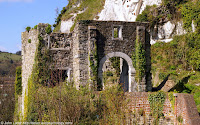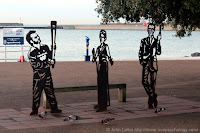After the video there are close-ups of numbers 1 to 10 of the mainly historical local landmarks that are mentioned in the commentary.
A second post, 2/2 First Covid-19 Lockdown Cycle Ride, contains close-ups of landmarks 11 to 20 (nb "First" in both titles indicates that I'll be making another video of the same route):
The video was filmed on Sunday, 10th of May 2020, using a head-mounted GoPro Hero 8 Black action camera and its built-in microphones.
 |
| Time Lapse Video Start |
Two days later I made a three-minute GoPro "Time Warp" (time lapse) video with commentary.
It contains a sequence that also shows the promenade from the Eastern Docks to the New Marina Pier.
Local landmarks, numbers 1 to 10:
Click on a thumbnail for a larger view, or any text link to go to the related blog post.
 |
| Charles Lightoller in Dover |
Former home of Charles Lightoller, survivor of the 1912 RMS Titanic iceberg disaster.
Moved here in 1916 during World War One after joining the Dover Patrol.
 |
| 1 East Cliff (Marine Parade), Dover |
Former home of General Sir Henry Le Geyt Bruce, Knight Commander of the Bath, 1824-1899.
Transferred from Bengal Artillery to Royal Artillery after 1857 Indian Mutiny.
Seaplane Station
First World War RAF or RFC squadron location.
 |
| Moat's Bulwark, A20 Townwall Street |
One of King Henry VIII's 'little forts' of which there were three in Dover.
The other two being the Black Bulwark and Archcliffe Fort.
 |
| Dover Castle and Gateway Flats |
Built as a result of damage sustained during the Second World War.
The Gateway, with 221 flats that all have views of the English Channel, was completed in October 1959 at a cost of one million pounds.
 |
| Lord Warden House, DWDR |
Where Louis Blériot (link to blog post) had breakfast after the first flight across the English Channel in 1909.
Ex-HMS Wasp in World War II. Now used by freight agents.
 |
| Matthew Webb, Dover Seafront |
Bust (or statue) symbolically rests on fishes and seashell above plinth,
First recorded person to swim the English Channel in 1875. Died Niagara Falls 1883 (USA and Canada border).
 |
| Charles Rolls facing Strait of Dover |
In 1910, he became the first man to fly non-stop across the English Channel and back again.
Co-founder of the Royal Aero Club and Rolls-Royce Motor Cars.
 |
| Every One Remembered Statue |
First World War Centenary Commemorative Sculpture by Mark Humphrey.
Located in Granville Gardens, symbolically facing the English Channel, France, and the Western Front beyond.
 |
| Dover Seafront Promenade |
Silhouette sculpture of Jamie Clark, 2012 Olympic Games Torch holder; Dame Vera Lynn (WW2 song, There'll be Bluebirds over the White Cliffs of Dover; Ian Fleming, author of 007 James Bond novels.
Cycling route map and biometrics are on this Polar Flow web page.
Abridged versions of this post are also on Facebook and Twitter.

No comments:
Post a Comment